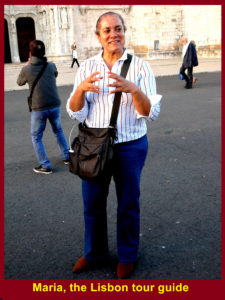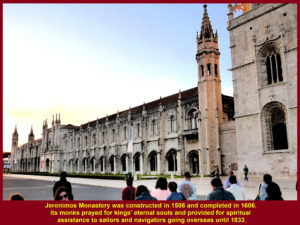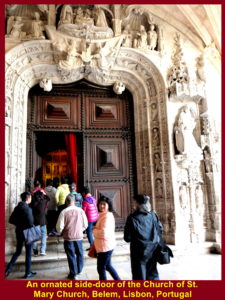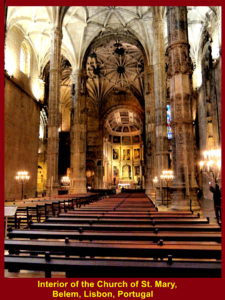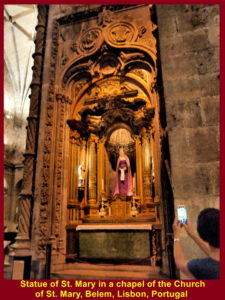Spain & Portugal Travel Part V: Lisbon
Spain & Portugal Travel Part V: Lisbon
Lisbon
Day 5 Friday, 26 October 2018
On this day, we left Porto in the morning and travelled to Lisbon, the capital of Portugal, which is 320 km in the south and the time for the journey would be 3 hours 30 minutes.
Map showing location of Lisbon
Maria, the Lisbon Tour-Guide
When we arrived at Lisbon, Maria, a local tour-guide welcomed us and brought us round to see a few historical landmarks.
Jeronimos Monastery, Belem, Lisbon
The first historical landmark Maria brought us to see was Jeronimos Monastery which was a few hundred metres from River Tagus in Belem, Lisbon.
The monastery was constructed in 1506 and completed 100 years later. The construction was started by King Manuel I of Portugal(1469-1521) and funded by taxes on goods imported from overseas.
The monks of the Order of Saint Jerome at the monastery gave spiritual guidance to sailors during the “Age of Discoveries” and prayed for the King Manuel I’s soul.
Jeronimos Monastery
Writer and Wife visited Jeronimos Monastery
Southern Entrance of the Church of St. Mary, Jeronimos Monastery
The monastery has a church, Church of St. Mary, adjacent to it. The southern entrance of the church is beautifully decorated with statuettes of saints.
Southern Entrance of the Church
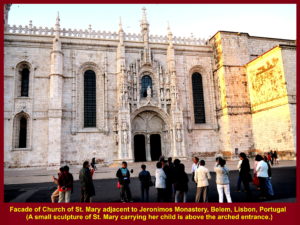
The southern entrance of the Church of St. Mary that is adjacent to Jeronimos Monastery in Belem, Lisbon
Western Entrance of the Church of St. Mary
The western entrance of the Church of St. Mary is also beautifully decorated with statuettes of saints.
Western Entrance of the Church
Interior of the Church of St. Mary
The nave in the church is long and the ceiling is high.
Interior of the Church
St. Mary Chapel in the Church
There is a chapel in the church that is dedicated to St. Mary. The worshipers believed that St. Mary brought back the sailors home, safely, during the “Age of Discoveries” from 15th. until 17th. Century.
St. Mary Chapel in the Church
Tombs of Great Portuguese Figures
In the church there are tombs of famous figures and royal members, such as the tombs of Vasco da Gama(1460-1524) who discovered a sea route to India in 1498, Luis Vaz de Camoes(1524-1580) who was a famous Portuguese writer glorifying the triumphs of Vasco da Gama, King Manuel I(1469-1521) and King Sebastian(1557-1578) to name a few.
Tomb of Vasco da Gama(1460-1524)
Tomb of Luis Vaz de Camoes(1524-1580)
Archaeological and Maritime Museums
In the west wing of Jeronimos Monastery is a long building that houses the National Archaeological Museum and Maritime Museum now.
Monument to Discoveries, Belem, Lisbon
Then we left Jeronimos Monastery and went to see a huge monument erected on the riverbank of River Tagus in 1939. It is a few hundred metres from the monastery.
It is known as Monument to Discoveries created in memory of the brave Portuguese navigators who went overseas to discover new foreign lands in the 15th.-17th Century period.
It looks like a caravel, a Portuguese traditional ship, carrying the Portuguese people to new foreign lands in South America, Africa and South Asia.
Monument to Discoveries
Close-up of Monument to Discoveries

Monument to Discoveries that looks like a caravel carrying brave Portuguese navigators to new foreign lands
Maps of Portuguese Discoveries
On the floor in front of the Monument to Discoveries, there are two large maps. One is showing the places and years in America and Africa, and the other South Asia discovered by the Portuguese navigators in the 15th.-17th. Century period.
Portuguese Discoveries in Africa
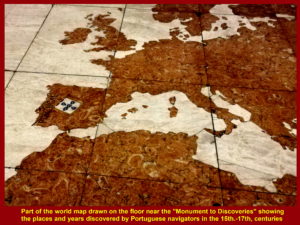
Map on the floor in front of the Monument to Discoveries showing the places and years of Portuguese discoveries in America and Africa
Portuguese Discoveries in South Asia
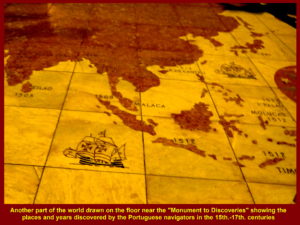
Map of Asia on the floor in front of the Monument to Discoveries showing the places and years of Portuguese discoveries in South Asia
View of the Monument to Discoveries, 25th. April Bridge and Statue of Jesus the King
Standing at a spot on the bank of River Tagus, a visitor can see three main structures, viz. Monument to Discoveries on the left, 25th. April Bridge over River Tagus and large, white Statue of Jesus the King in the distance on the right.
Monument, Bridge and Statue
25th. April Bridge
The 25th. April Bridge is a 2277 metre-long suspension bridge that looks like the one in San Francisco in California. It has two decks. The upper deck carries six car-lanes and the lower one carries a double track railway.
When the bridge was opened in 1966, it was called Salazar Bridge. Then in 1974 it was renamed “25th. April Bridge” in commemoration of the Carnation Revolution. The revolution was a military coup organized by the Military Forces Movement to overthrow the authoritarian regime of Estado Nova on 25th. April 1974.
Tower of Belem
A 30 metre-high fortress was built on an islet in River Tagus in Belem in the early 15th. Century to protect Lisbon from being invaded by Spain or France. Built in Portuguese Manueline style, it is known as Tower of Belem or Tower of St. Vincent. Owing to the deposit of soil in River Tagus, the fortress is now seen to be on the bank of the river.
In 1983 Tower of Belem was designated as a UNESCO World Heritage site due to its important role it played in the Portuguese Age of Discoveries.
Tower of Belem

Tower of Belem built in the early 15th. Century to protect Lisbon from being attacked by France or Spain.
Sunset at Belem, Lisbon
It was sunset when we were going to leave Belem, a historical maritime place in Lisbon.
Before we left Belem, we had a last look at the river-mouth of River Tagus in the west. In the distance, we saw a silhouette of a larger fortress against the colourful sky at sunset. It is near the port of Lisbon.
Sunset at Belem

Sunset at Belem, Lisbon, and silhouette of a fortress, Sao Juliao da Barra, at the mouth of River Tagus
Fortress of Sao Juliao da Barra
That fortress is known as Sao Juliao da Barra. In 1556 King John III of Portugal(1502-1557) ordered the fortress to be constructed at the mouth of River Tagus to protect the Lisbon port and city from being attacked by foreign invaders.
Soon we left Belem for dinner and stayed at a hotel for a night, Hotel Leziria Parque, in Lisbon.
Hotel Leziria Parque, Lisbon
Next Destination
We would be going to Seville in Spain the following day. It is 450 km south-east of Lisbon and the journey would take 4 hours 30 minutes.
Previous(Porto) / Home / Next(Seville)
Places visited during Spain & Portugal Tour(22 Oct-02 Nov 2018):
Toledo Madrid Salamanca Porto Lisbon Seville Cordobo Granada Valencia Barcelona


